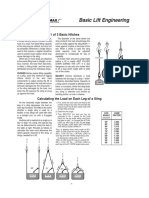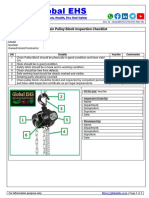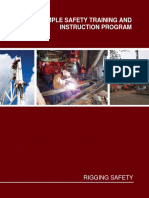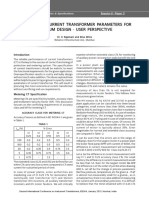Calculating The Load of Basket Hitches and Bridles
Calculating The Load of Basket Hitches and Bridles
Uploaded by
bilo1984Copyright:
Available Formats
Calculating The Load of Basket Hitches and Bridles
Calculating The Load of Basket Hitches and Bridles
Uploaded by
bilo1984Original Description:
Original Title
Copyright
Available Formats
Share this document
Did you find this document useful?
Is this content inappropriate?
Copyright:
Available Formats
Calculating The Load of Basket Hitches and Bridles
Calculating The Load of Basket Hitches and Bridles
Uploaded by
bilo1984Copyright:
Available Formats
Calculating the load of basket hitches and bridles
hen youre calculating the load of basket
hitches and bridles, remember that as the
horizontal angle of a sling decreases, the resultant
load on each leg increases.
The horizontal angle of bridles with three or more
legs is measured the same way as horizontal sling
angles of two-legged hitches. If a
bridle is designed with different leg
lengths, it may result in different
horizontal angles. The load on
each leg must be calculated
based on the position of the
slings and the location of the
lifts center of gravity.
ADJUSTING THE RATED CAPACITY OF A CHOKER HITCH
Due to the body of the sling being used in the
choke, there is a reduction in rated capacity. This
is reflected in the choker rated capacity tables.
Another reduction that must be considered is due to
the angle of the choke (not the angle of the leg of
the sling).
If the load is hanging free, the normal choke angle
is approximately 135 degrees. When lifting and
THREE-STEP FORMULA FOR CALCULATING
LOAD PER SLING LEG
These calculations assume that the center of gravity
is equal distance from all of the lifting points,
and the sling angles are the same. If not, more
complicated engineering calculations are needed.
1. Divide the weight of your total load by the number
of legs you are using. This gives you the load per
leg if the lift were being made with all legs lifting
vertically.
2. Measure the angle between the legs of the sling
and the horizontal plane.
3. Multiply the load per leg that you calculated in
step 1 by the load factor for the leg angle you are
using. Use the Load factor guidelines table on the
next page to determine the load factor.
The result is the actual load on each leg of the sling
for this lift and angle. The actual load must never
exceed the slings vertical rated capacity.
Warning: Slings shall not be used with horizontal
angles less than 30.
turning a load using a choker hitch, it is
not uncommon to have a severe bend
at the choke. When a choker hitch
is used at an angle of less than
120 degrees, you must reduce
the hitchs rated capacity as
shown in the chart at right.
You always must adjust the
rated capacity of the wire
rope sling whenever you use
a choker hitch to shift, turn
or control a load, or when the
pull is against the choke in a multi-leg lift.
As always, if more than one sling is used and the legs
are not vertical, a further reduction in rated capacity
must be made for the sling angle.
Warning: Choker hitches at angles greater than
135 degrees are not recommended since they are
unstable. Extreme care should be taken to determine
the angle of choke as accurately as possible.
EXAMPLES OF HOW TO CALCULATE SLING LEG LOADS
1. Total load is 1,000 lbs. divided by two legs
500 lbs. load per leg if vertical lift.
2. Horizontal sling angle is 60 degrees.
3. Multiply 500 lbs. by 1.154 load factor (from
table) = 577 lbs. actual load per leg.
1. Total load is 1,000 lbs. divided by two legs
500 lbs. load per leg if vertical lift.
2. Horizontal sling angle is 45 degrees.
3. Multiply 500 lbs. by 1.414 load factor (from
table) = 707 lbs. actual load per leg.
1. Total load is 1,000 lbs. divided by two legs
500 lbs. load per leg if vertical lift.
2. Horizontal sling angle is 30 degrees.
3. Multiply 500 lbs. by 2 load factor (from table)
= 1000 lbs. actual load per leg.
www.unionrope.com
Sound lifting practices
here are four primary factors to take into
consideration when lifting a load.
They are: (1) the physical parameters of the load;
(2) the number of legs and the angle they make
with the horizontal; (3) the rated capacity of the
sling; and (4) the condition of the sling.
PHYSICAL PARAMETERS OF THE LOAD
The size of the object to be lifted, and particularly
the location of lifting points, will affect sling
selection. The weight of the lift, while a critical
component, is only a part of the information. The
location of the center of gravity is also necessary to
determine sling loadings.
If the load has small diameter corners, protective
blocking or softeners must be used so that sling
capacity isnt reduced. Also, if lifting a painted
object or an object with a finished surface, padding
or softeners may be needed between the sling and
the load to protect the load.
NUMBER OF LEGS AND ANGLE WITH THE HORIZONTAL
As the angle formed by the sling leg and the
horizontal decreases, the rated capacity of the
sling also decreases. In other words, the smaller
the angle between the sling leg and the horizontal,
the greater the load on the sling leg. The minimum
angle allowed is 30 degrees.
RATED CAPACITY
The rated capacity of a sling must never be exceeded.
The rated capacity is based both on sling fabrication
components (minimum breaking force of rope used,
splicing efficiency, number of parts of rope in sling and
number of sling legs) and sling application components
(angle of legs, type of hitch, D/d ratios, etc.).
If you are using one wire rope sling in a vertical hitch,
you can utilize the full rated lifting capacity of the
sling, but you must not exceed that lifting capacity.
If you are using two wire rope slings in a vertical hitch
(called a 2-legged bridle hitch) in a straight lift, the
load on each leg increases as the angle between the
leg and the horizontal plane decreases.
Whenever you lift a load with the legs of a sling at
an angle, you can calculate the actual load per leg by
using the following three-step formula.
CONDITION OF SLING
Each sling must be inspected daily. If the sling does
not pass inspection, do not use. (See Inspection and
Removal Criteria in Wire Rope Sling Guide.)
LOAD FACTOR
GUIDELINES
Leg
angle
Load
factor
CAPACITY DECREASES
WITH ANGLE
90 1.000
85 1.003
80 1.015
75 1.035
70 1.064
65 1.103
60 1.154
55 1.220
50 1.305
45 1.414
40 1.555
35 1.743
30 2.000
Angle Rated
of choke
Capacity
in degrees Percent*
Over 120
90-120
60- 89
30-59
0-29
100%
87%
74%
62%
49%
*Percent of slings
rated capacity in
a choker hitch.
Form No. 2029
ph: +1.816.270.4700
info@wirecoworldgroup.com
www.unionrope.com
You might also like
- A59 Q&a 3Document15 pagesA59 Q&a 3Jason ConnellNo ratings yet
- Shell Emergency Preparedness and Office Closure ProceduresDocument6 pagesShell Emergency Preparedness and Office Closure Proceduresbilo1984No ratings yet
- SLB LiftingDocument98 pagesSLB Liftingbilo1984100% (11)
- 2 - Hse Legal and Other RequirmentDocument8 pages2 - Hse Legal and Other Requirmentbilo1984No ratings yet
- User Manual - Man BasketsDocument14 pagesUser Manual - Man BasketsKin Lai Kong100% (1)
- Mobile CraneDocument84 pagesMobile CraneFar Away100% (1)
- Sling HitchesDocument12 pagesSling Hitchesamin110110No ratings yet
- 8 LolerDocument8 pages8 Lolerbilo1984No ratings yet
- 23 - Man Riding ProcedureDocument17 pages23 - Man Riding Procedurebilo1984No ratings yet
- Lift Plan and Risk AssessmentDocument120 pagesLift Plan and Risk Assessmentbilo198475% (4)
- LOG-001-T-01 WORKSHOP 2021-04-14 MANUAL REQUISITION HYD21WR 0232 - 0234Document381 pagesLOG-001-T-01 WORKSHOP 2021-04-14 MANUAL REQUISITION HYD21WR 0232 - 0234Ernest Ngosa SawasawaNo ratings yet
- The PERG RatioDocument17 pagesThe PERG RatioStockopedia100% (1)
- ManualDocument44 pagesManualjillianixNo ratings yet
- Lift EngineeringDocument3 pagesLift EngineeringyogihardNo ratings yet
- Lifting and Rigging OperationsDocument36 pagesLifting and Rigging OperationsB.r. SharmaNo ratings yet
- New LiftingDocument88 pagesNew LiftingGaurav JindalNo ratings yet
- TaiLing by Duo CraneDocument9 pagesTaiLing by Duo CraneHaGun Gunawan100% (1)
- Rigging TechniquesDocument27 pagesRigging TechniquesDeepak ShettyNo ratings yet
- Generators, and A Wide Variety of Other Building MaterialsDocument17 pagesGenerators, and A Wide Variety of Other Building MaterialsAmeerUlHaqNo ratings yet
- Instructions For The Safe Use Of: ShacklesDocument2 pagesInstructions For The Safe Use Of: ShacklesAmeerUlHaqNo ratings yet
- Sling Wire Calculation For LiftingDocument1 pageSling Wire Calculation For LiftingPo RaksmeyNo ratings yet
- 2 0 2 0 Rigging Study & Lifting Study: SeptemberDocument57 pages2 0 2 0 Rigging Study & Lifting Study: SeptemberTaufan Arif ZulkarnainNo ratings yet
- Operationalising Lifting Plan Safe Cranes OperationDocument62 pagesOperationalising Lifting Plan Safe Cranes Operationtklok99100% (1)
- Patented! Rotating Hand Chain GuideDocument15 pagesPatented! Rotating Hand Chain GuideElsad HuseynovNo ratings yet
- Riggers Quiz: Name: - DateDocument1 pageRiggers Quiz: Name: - Dategunnery02No ratings yet
- Critical Lift Critical Lift Plan Required YES: (Note: Never Exceed 75% of Each Crane's Capacity in A Multi-Crane Lift.)Document4 pagesCritical Lift Critical Lift Plan Required YES: (Note: Never Exceed 75% of Each Crane's Capacity in A Multi-Crane Lift.)cute1t100% (1)
- Formula Lifting Plan PDFDocument6 pagesFormula Lifting Plan PDFAdhi YusufNo ratings yet
- Ruud Optimal SecuringDocument28 pagesRuud Optimal SecuringStian Eikanger SkålevikNo ratings yet
- Gunnebo Lifting ManualDocument59 pagesGunnebo Lifting Manualseawize100% (1)
- Technical Test Theory: Compact Crane A66Document6 pagesTechnical Test Theory: Compact Crane A66memoNo ratings yet
- Review Safety Rigging and LiftingDocument4 pagesReview Safety Rigging and Liftingferry ferdiansyah pradanaNo ratings yet
- Liftex Catalog 2016Document60 pagesLiftex Catalog 2016Alberth Mauricio Casteblanco GomezNo ratings yet
- Mobile Crane Operator: Course EbookDocument11 pagesMobile Crane Operator: Course EbookEdu MayorNo ratings yet
- LiftPlannerSoftwareCustomerLiftPlans PDFDocument36 pagesLiftPlannerSoftwareCustomerLiftPlans PDFr4mms3sNo ratings yet
- Lecture Preparation Unit 4Document50 pagesLecture Preparation Unit 4Prem VikasNo ratings yet
- Basic Lifting PlanDocument1 pageBasic Lifting PlanParashuram PatilNo ratings yet
- Serious Lift Calculation and Authorization FormDocument2 pagesSerious Lift Calculation and Authorization FormAbdulKather100% (1)
- OSHA Man Basket User ManualDocument9 pagesOSHA Man Basket User Manualwalid EttihNo ratings yet
- Ground Bearing Pressure Below Crane Mats Calculation: Model: Crane SCX-2800 On Barge AST 1853Document1 pageGround Bearing Pressure Below Crane Mats Calculation: Model: Crane SCX-2800 On Barge AST 1853ali akbarNo ratings yet
- Lifting Equipments and Procedure: Compiled by Safety Trainees PeclDocument83 pagesLifting Equipments and Procedure: Compiled by Safety Trainees PeclvarunstuffNo ratings yet
- Crane Safety WorkbookDocument34 pagesCrane Safety WorkbookozdoguNo ratings yet
- Web Slings-Cintas CERTEXDocument34 pagesWeb Slings-Cintas CERTEXleonardo_barros_48No ratings yet
- Wire Rope Slings Si 2 - 2 EmmDocument2 pagesWire Rope Slings Si 2 - 2 EmmheppyfaebanffNo ratings yet
- Safe Rigging PracticeDocument81 pagesSafe Rigging PracticeAlvinSuparmanNo ratings yet
- Chain Pulley Block Inspection Checklist Global EHS 030Document1 pageChain Pulley Block Inspection Checklist Global EHS 030Safety MohiniNo ratings yet
- Wire Rope Slings by Safety SlingDocument4 pagesWire Rope Slings by Safety SlingRajNo ratings yet
- Tandem LiftingDocument7 pagesTandem Liftingraman1408295No ratings yet
- Crane and Rigging - PDF - (382245420)Document23 pagesCrane and Rigging - PDF - (382245420)bilo1984No ratings yet
- Safety in Mobile CranesDocument60 pagesSafety in Mobile CranesSwapnil pupulwad100% (1)
- Forklift - Basic ModuleDocument31 pagesForklift - Basic Moduleimran ali kazmiNo ratings yet
- Rigging - Sling HitchesDocument54 pagesRigging - Sling HitchesIng. Alejandro Valencia HerreraNo ratings yet
- Rigging Saftey Program Docx e RDocument48 pagesRigging Saftey Program Docx e RTawfik Mohamed Abu ZaidNo ratings yet
- CC Brochure TowerCranes DIN en 9896-0Document19 pagesCC Brochure TowerCranes DIN en 9896-0PhanHathamNo ratings yet
- LOLERDocument82 pagesLOLERNguyen Phuc LinhNo ratings yet
- Rigging - ICE Level 3 - 01 07 14Document5 pagesRigging - ICE Level 3 - 01 07 14Dak KaizNo ratings yet
- How To Review A Lift PlanDocument64 pagesHow To Review A Lift PlanSubhi El Haj Saleh100% (1)
- A62 CPCS Crane Lifting Operations Supervisor AnswersDocument6 pagesA62 CPCS Crane Lifting Operations Supervisor AnswersmavwingNo ratings yet
- MFD Procedure: Lifting & HoistingDocument16 pagesMFD Procedure: Lifting & HoistingMohammed JassimNo ratings yet
- Rigging and Lifting Handbook SampleDocument26 pagesRigging and Lifting Handbook Samplemohan100% (1)
- Slings-Chains+wir RopesDocument30 pagesSlings-Chains+wir RopestonyNo ratings yet
- Banksman Slinging R2Document31 pagesBanksman Slinging R2Ilyas Zeri100% (1)
- Rci BS 7262Document3 pagesRci BS 7262Rizwan AhmedNo ratings yet
- HSE Guidance Safe Use Magnetic Lifting DevicesDocument9 pagesHSE Guidance Safe Use Magnetic Lifting DevicesNixNo ratings yet
- Construction Cranes PPT v.05.18.15Document32 pagesConstruction Cranes PPT v.05.18.15yazardNo ratings yet
- (More, Click Here) : Formula For Adjusting The Working Load Limit of A Sling or Sling Leg Used at An AngleDocument3 pages(More, Click Here) : Formula For Adjusting The Working Load Limit of A Sling or Sling Leg Used at An Anglegplese0No ratings yet
- TF 69 Lifting Apparatus MullenDocument6 pagesTF 69 Lifting Apparatus MullenKar TikNo ratings yet
- WET 2400 HW Safety Packet 5 Rigging 2Document6 pagesWET 2400 HW Safety Packet 5 Rigging 2Mohammed SeedatNo ratings yet
- Awaernss and TrainingDocument11 pagesAwaernss and Trainingbilo1984100% (1)
- Risk Tolerance Methodology v2Document22 pagesRisk Tolerance Methodology v2bilo1984No ratings yet
- 5.4 Work Permit SystemDocument14 pages5.4 Work Permit Systembilo1984100% (1)
- IDC HSEF 8.2 Rig Emergency Response Team Organization .Document1 pageIDC HSEF 8.2 Rig Emergency Response Team Organization .bilo1984No ratings yet
- 2.1 - List of HSE LegislationsDocument1 page2.1 - List of HSE Legislationsbilo1984No ratings yet
- Human Factors Engineering HFEDocument22 pagesHuman Factors Engineering HFEbilo1984No ratings yet
- Aspect & Impact Form - 1.2Document2 pagesAspect & Impact Form - 1.2bilo1984No ratings yet
- ATEX PosterDocument1 pageATEX Posterbilo1984No ratings yet
- HSE-BMS-011 Crane & Lifting SafetyDocument51 pagesHSE-BMS-011 Crane & Lifting Safetybilo1984100% (2)
- Near Miss Investigation Report Version 12-Nov-2019Document14 pagesNear Miss Investigation Report Version 12-Nov-2019bilo1984No ratings yet
- IDC 58 30-Oct-2019 - Dropped Empty Bottle of WaterDocument18 pagesIDC 58 30-Oct-2019 - Dropped Empty Bottle of Waterbilo1984No ratings yet
- 2020 Draft HSE Plan Ucd CampDocument17 pages2020 Draft HSE Plan Ucd Campbilo198450% (2)
- 3 - Blowout PlanDocument9 pages3 - Blowout Planbilo1984No ratings yet
- Risk Assessment Proc - 1Document35 pagesRisk Assessment Proc - 1bilo1984No ratings yet
- Process Safety Management (PSM) : Module Two - Overview of The PSM RuleDocument40 pagesProcess Safety Management (PSM) : Module Two - Overview of The PSM Rulebilo1984No ratings yet
- Identifying and Evaluating Hazards in Research Laboratories DraftDocument133 pagesIdentifying and Evaluating Hazards in Research Laboratories Draftbilo1984No ratings yet
- 8 LolerDocument8 pages8 Lolerbilo1984No ratings yet
- Sheet of Man RidingDocument1 pageSheet of Man Ridingbilo1984No ratings yet
- Pick Carry Cranes Risk AssessmentDocument45 pagesPick Carry Cranes Risk Assessmentbilo1984No ratings yet
- Training: Course Tutors Are NVQ A1/D32/D33 QualifiedDocument1 pageTraining: Course Tutors Are NVQ A1/D32/D33 QualifiedAmeerUlHaqNo ratings yet
- 08 - Sling Hatches and ApplicationDocument56 pages08 - Sling Hatches and Applicationbilo1984No ratings yet
- Selection of Current Transformer Parameters For Optimum Design - User PerspectiveDocument6 pagesSelection of Current Transformer Parameters For Optimum Design - User PerspectivePradeep Singh100% (2)
- I CT Lecture 01 Computer Definitions and Basics Compatibility Mode PDFDocument29 pagesI CT Lecture 01 Computer Definitions and Basics Compatibility Mode PDFAsadNo ratings yet
- Influence of Size and Depth On Load Capacities of Shallow Foundations Under Limiting Settlement CriteriaDocument9 pagesInfluence of Size and Depth On Load Capacities of Shallow Foundations Under Limiting Settlement CriteriaAbdelmoez ElgarfNo ratings yet
- Chapter 22 (1) .ElectDocument28 pagesChapter 22 (1) .ElectOsama HassanNo ratings yet
- Guide Convolutional Neural Network CNNDocument25 pagesGuide Convolutional Neural Network CNNfaisal100% (1)
- UnzipDocument13 pagesUnzipNaga LakshmaiahNo ratings yet
- Prewash Procedure Pages From MARPOLDocument7 pagesPrewash Procedure Pages From MARPOLosmangonimarinerNo ratings yet
- NotsablosomDocument318 pagesNotsablosomசிவசங்கர் முத்துமல்லுNo ratings yet
- Data Formatting: The Input File - . .: Tag Number YearDocument9 pagesData Formatting: The Input File - . .: Tag Number YearJavier Fernandez de CordovaNo ratings yet
- Dynamic Wind ResponseDocument7 pagesDynamic Wind Responsejatin kalraNo ratings yet
- Resume123 PDFDocument2 pagesResume123 PDFsamiksha choudharyNo ratings yet
- Magnetism PDFDocument2 pagesMagnetism PDFavinash960No ratings yet
- Basics of Non-Ideal FlowDocument32 pagesBasics of Non-Ideal FlowKavali Koteswar ReddyNo ratings yet
- Weather Corrected PRDocument22 pagesWeather Corrected PRAzree Mohd NoorNo ratings yet
- Guideform Specification REV615 758528 ENbDocument4 pagesGuideform Specification REV615 758528 ENbAli DoostmohammadiNo ratings yet
- Analaytical Chemistry Module 2Document50 pagesAnalaytical Chemistry Module 2May Joy VasquezNo ratings yet
- Can Xu 2022Document14 pagesCan Xu 2022Fábio A. BodnarNo ratings yet
- Midterm Study GuideDocument8 pagesMidterm Study GuideAustin TroutNo ratings yet
- Convert Decimals To FractionsDocument11 pagesConvert Decimals To FractionsKenneth VillegasNo ratings yet
- 2a Guess Paper 4 PDFDocument2 pages2a Guess Paper 4 PDFCharvitha PhaniNo ratings yet
- Polygon FillingDocument6 pagesPolygon FillingVeer SinghNo ratings yet
- Guide DB2A Table Controlled PartitioningDocument50 pagesGuide DB2A Table Controlled Partitioningrmsr_7576No ratings yet
- Ch. 11: Liquids and Intermolecular Forces: - GasesDocument22 pagesCh. 11: Liquids and Intermolecular Forces: - GasesJozel Bryan Mestiola TerrìbleNo ratings yet
- 555 Timer ICDocument6 pages555 Timer ICSrđan PavićNo ratings yet
- Katalog RuchiDocument77 pagesKatalog Ruchimuliawan.anggaNo ratings yet
- Methyl Red (MR) Test-Principle, Procedure and Result InterpretationDocument2 pagesMethyl Red (MR) Test-Principle, Procedure and Result InterpretationMd Ahsanul HaqueNo ratings yet
- Vectors WorksheetDocument1 pageVectors WorksheetLuanMuçaNo ratings yet
- Unit 1 UpdatedDocument29 pagesUnit 1 UpdatedAmit TripathiNo ratings yet




















































































































